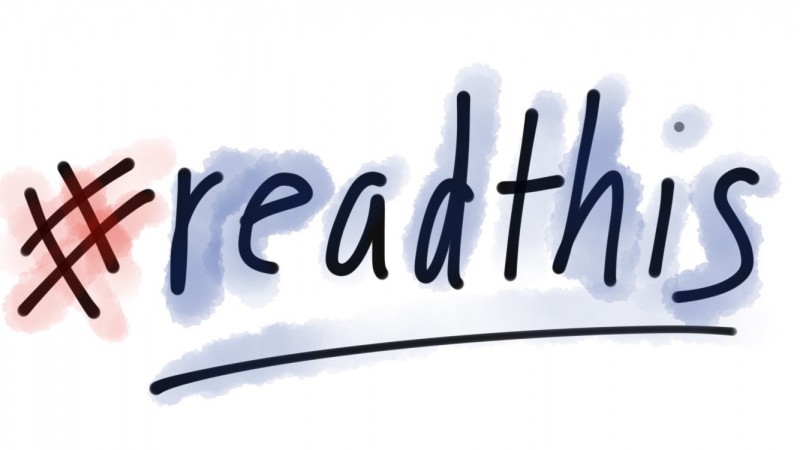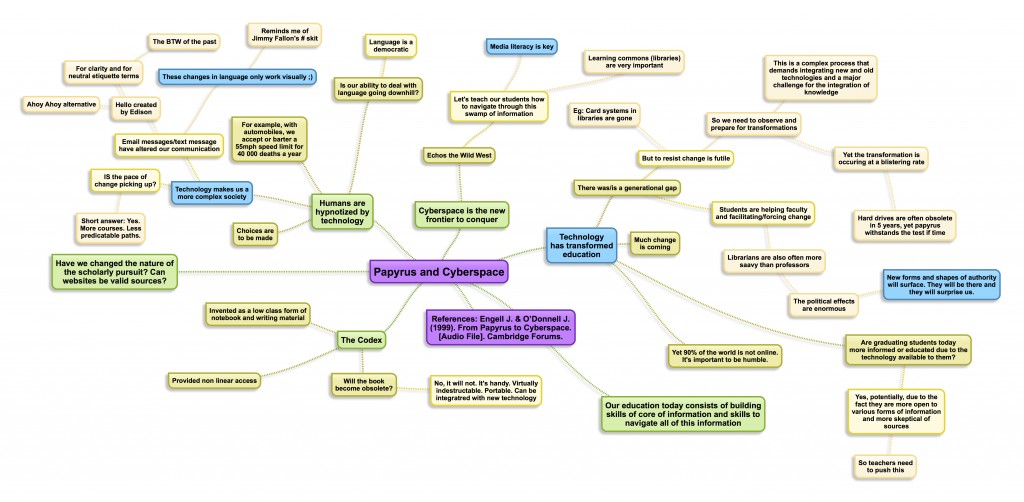Papyrus Thoughts
My thoughts so far,
Technology will always have drawbacks and benefits and this recording certainly highlighted this fact. When listening to the audio recording I began to write on pencil and paper. I found it was challenging to listen and write so I had to pause, record notes and continue again. As I continued listening I found this form of brainstorming wasn’t sufficient enough. For my purposes, I began using an application called Simple Mind. I was able to get what I felt were key points onto a medium that was better suited for sharing with everyone. I wonder if anyone else tried this method? I attached the document as a PDF.
This audio recording was a surprisingly noteworthy discussion on the history (and future) of written word and the explosion of cyberspace. Although somewhat dated (in terms of examples) I felt the questions that were asked and explained were thoughtful and still relevant. One key topic I enjoyed was the lifespan of technology. As they discussed the rise and demise of the codex (and other technologies before) I began to think about our modern forms of technology. Will they withstand or will they be lost like other research before. This reminded me of an article from UBC, where it stated, “Eighty per cent of scientific data are lost within two decades, according to a new study that tracks the accessibility of data over time.” As long as you can guarantee that your research is secure, you can keep it indefinitely. How one secures their research is a valid question and this seems like a pressing issue for our society. As O’Donnell and Engell mentioned, the transformation is taking place at a blistering rate.
Our language is the reflection of our present society. It’s no wonder that O’Donnell and Engell discussed the changes in writing that have infiltrated email. We now see those changes in messaging programs like WhatsApp, Viber and WeChat. Our society is pressed with growing pressures to be connected all the time. We are hypnotized by technology. Are these abbreviations that we use (such as emoticons and shortcuts) increasing due to constant drain of connectivity we can often feel?
I really enjoyed the portion on the history of the word hello. As one who often shudders when my students include lol, omg, or other abbreviations, it was entertaining to hear how the creation of a word led to its inclusion in the English language. It certainly made me question my judgment of their inclusions. Just as email included new forms of communication, the use of emoticons, hash-tags and abbreviations has added a new dimension to our language. It will be interesting to see how these continue with the increase of video messaging. If anything, this discussion highlighted the need to observe and prepare for transformations in technology. As a result of these changes, our education from kindergarten to post secondary is transforming – hopefully I can keep up.
::: Matt
References
Engell J. & O’Donnell J. (1999). From Papyrus to Cyberspace. [Audio File]. Cambridge Forums.
Scientific data lost at alarming rate. (2013, December 19). Retrieved from http://news.ubc.ca/2013/12/19/scientific-data-lost-at-alarming-rate/



Matt –
I really enjoyed reviewing your mindmap. I found myself taking written notes while listening to the audio presentation as well. It is amazing to reflect on how we learn best. For myself, it is not sufficient just to listen – I feel a great urge to write down notes or ideas that I find particular interesting…
Matt, I love this map, I really like it. Is a very good glimpse of the discussion, which is way more important than the readings. You are (either voluntarily or circumstantially) engaging in a scholarly practice known as “distant reading”, which is a technology in itself. Take a look at this book if you find the time:
Moretti, F. (2005). Graphs, maps, trees: abstract models for a literary history. London ; New York: Verso.
Thank you for the compliment! I have to admit I am intrigued to read about this method of “distant reading.” I’m also appreciative of the recommendation and will look into Moretti’s models. A quick search led to me to an article that discussed this topic by Kathryn Schulz in the NY Times. At first glance it seems Moretti has some interesting (radical) insights!
::: Matt
Reference
Schulz, K. (2011, June 24). The Mechanic Muse – What Is Distant Reading? – NYTimes.com. Retrieved from http://www.nytimes.com/2011/06/26/books/review/the-mechanic-muse-what-is-distant-reading.html?_r=0
Matt, that is a neat mind map! Mind if I ask what app or program you used to create it? I know there are many mind map programs and apps out there.
I also felt that the recording was dated. But around the 1/3 mark of the recording when they started taking questions, I found it quite fascinating as the dialog often talked about technology that is now long gone but was current at the time of the recording. Of course at my age, I clearly remember all of this. It also crossed my mind that you might consider it the industrialization age around the time period of 1990 – 2000. It was a time of rapid growth of internet communication and technology. I remember over the period of a few short years, going from a 2.4kbps modem (yes a modem, remember those?) to a 14.4kbps modem, to a 16.8kbps modem almost a couple of months later. Then I remember a rapid jump 56kbps modems and after that internet bandwidth and speed just skyrocketed. Today, bandwidth growth has levelled off since then. But from a technological point of view, I feel the levelling off effect is also partly caused by the sheer number of people online and not just some kind of plateau of technology.
Anyways, another interesting note about the audio recordings is their lack of mention of collaboration technology. If I were to summarize internet technology over the last 10-15 years into one word, it would be “collaboration”. You hardly see an application or game released today without some kind of collaboration or social feature. This didn’t exist in great numbers back then.
Thank you Daniel!
After trying a few different mind maps (including Bubbl.us and CMaps..) I found this one from the Apple App store called SimpleMind Free. It was simple (and free!).
Nice points about the rapid increase of technology and the internet. Certainly collaboration has held a pivotal position in the history of internet. How would you integrated this topic? Perhaps in the question period near the end?
::: Matt
Hi Matt,
Interesting “thoughts map”! last term (etec 510) in the given course resources I have found mindomo ” http://www.mindomo.com, I tried to use it for brainstorming. I like the way you use it. I want to know how did you use it, that is for brainstorming or just mapped your thoughts. Anyway, I like your mind map especially for codex– invented as a low class form of notebook.
Rakhshanda
Thanks for the tip everyone. Will need to give that a try. Although to be honest, I always like to use apps that do not tie me to any one device be it an iPad or Android. I prefer web-based apps that can be used on any device.
Hi Rakhshanda,
Thanks for the commenting – Mindomo looks interesting! I chose the app SimpleMind because I didn’t need to log it, or have internet access. I find with web-based programs I am limited to where I can think (unless I use up my data plan and make a hotspot).
I first began listening and writing on the program. As I progressed I added, and modified the structure of it. My goal was to get my ideas and those ideas of the audio onto a medium to share.
Matt
Hi Matt;
“an article from UBC, where it stated, ‘Eighty per cent of scientific data are lost within two decades, according to a new study that tracks the accessibility of data over time.’ As long as you can guarantee that your research is secure, you can keep it indefinitely.” Since we are going back in history …, this might explain why we are still theorizing over such constructions as the pyramids. They (the developers) would have wanted to keep their secrets and at the same time express their intelligence to those of authority. We think we know but we can’t be 100 % sure we know every detail there is to learn for the distant cultures. It keeps us busy searching for answers.
Great visual ‘mapping’
Terry
Thanks Terry! Interesting thoughts about the pyramids!
+1 on the visual mapping. I guess each of us who are interested may have a different method on doing this. Matt, how did you do it? Did you construct the map as you read? Did you annotate your reading then construct the map after?
Hey Daniel,
Yes, you were right to guess I made the map as I read. I paused, then wrote in the app. I would often rewind a little too, so it took more time than I initially anticipated but I think it was worth it for me. When it was done I modified things (colours, location etc) added other connections I held.
Matt
I will need to try that Matt.
Here is how I like to get through the course readings. Hope its not too old fashioned for this course!
https://goo.gl/D7SMv6